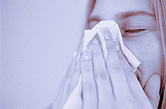
FRIDAY, April 16 (HealthDay News) — A cold winter followed by a sudden and sustained warming trend, not to mention the botanical blossoming that global warming has brought, has boosted pollen counts to near-record highs across the United States this spring, experts say.
All of that has led to one of the most miserable allergy seasons in recent memory for the 50 million Americans who find themselves suffering itchy eyes, runny noses and scratchy throats this time of year.
“In Atlanta, we recently saw the second highest pollen count ever — 5,733. A level of 1,500 is considered very high, so this was off the charts,” explained meteorologist Carl Parker, from The Weather Channel. Pollen counts are measured in grains of pollen per cubic meter in a sample that’s collected over a 24-hour period.
As so often happens, weather is largely to blame.
“Timing is everything and, in a lot of years, you might have bouts of warm followed by cold. This year, across a lot of the country, we were cold for a long time, and then the air pattern warmed and it was like we flipped a switch,” Parker said.
Adding to the problem “is the same system that’s bringing in the warm air has also been blocking rainstorms from coming in, and normally, rain comes through and knocks the pollen down, clearing things out,” he said.
The pollen problem is primarily affecting areas east of the Rocky Mountains, said Parker. In the west, he noted, there are still areas that are getting snow.
Another factor in the increased pollen counts is climate change. Parker said that concentration of carbon dioxide (CO2) have increased in the past 100 years, and plants thrive on increasing levels of CO2. “Some types of pollens have doubled because of climate change,” said Parker.
“CO2 is good for plants and they’re making more pollen,” agreed Dr. David Rosenstreich, director of the division of allergy and immunology at Montefiore Medical Center in New York City. In addition, he said, “Pollen seasons are lengthening a little bit because of global warming.”
Still, Rosenstreich said that counts will vary from year to year, and although they’re particularly high right now, they may not stay that way for the whole allergy season.
One bit of good news for allergy sufferers is that the allergy season is “on fast-forward,” he said. “It’s all happening right now.” Most of the tree pollens should start to decrease in the next couple of weeks.
Whatever the pollen count, Rosenstreich stressed that there’s no need to suffer through allergy symptoms. “We have medicines that can help,” he said.
If you’re taking preventive medications for your allergies, Rosenstreich said that it’s important to take them in advance and as directed by your doctor.
“Most allergy medicines work better to prevent allergic symptoms than to treat them when they’re in progress,” he explained.
Both Rosenstreich and Parker had other tips for those with allergies on high pollen count days:
- Stay indoors as much as possible. But, be sure to keep your windows closed so the pollen doesn’t get in. Parker said that if you must go out, it’s best to avoid the morning hours because pollen is much worse then.
- Keep your windows closed and run your air conditioner. It doesn’t need to be set to cool, just to filter the air. Make sure the filters for your air condition are clean, however.
- Use the air conditioning in your car to filter the air.
- If you have to do yard work, Parker suggested wearing a mask to help cut down on the amount of pollen you’ll breathe in.
And, finally, with a suggestion that’s sure to make mothers across America happy, Parker said he’d recently heard that eating certain vegetables, such as broccoli, cauliflower and Brussels sprouts might lessen allergy symptoms.
More information
Check the pollen counts where you live, by visiting the American Academy of Allergy, Asthma and Immunology.

